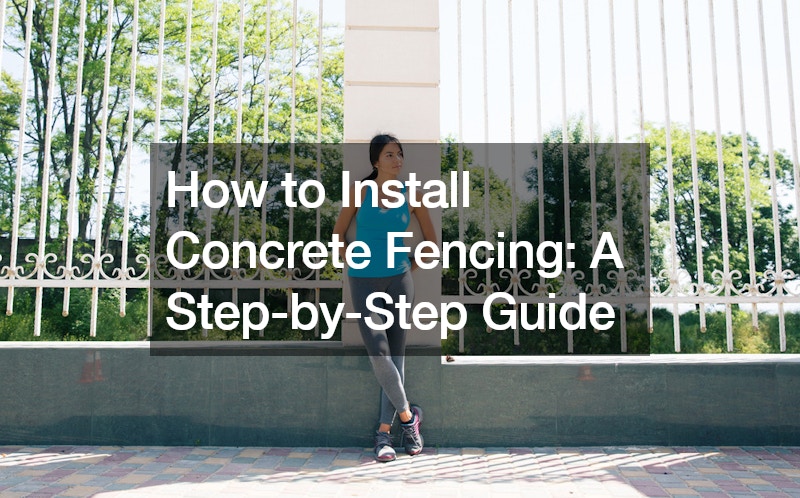
Concrete fencing offers durability and longevity, making it an excellent choice for securing your property and enhancing its aesthetics. Installing concrete fencing may seem daunting, but it can be a manageable DIY project with the right tools, materials, and know-how.
In this comprehensive guide, we’ll walk you through the process step by step, ensuring a successful and lasting installation.
Step 1: Preparation and Planning
thorough preparation and planning are essential before diving into the installation process. Begin by surveying your property to determine the fence line and mark it out clearly. Consider any obstacles or underground utilities to avoid accidental damage during excavation.
Consider the layout and design of your fence, including the height, style, and spacing between posts. If your fence will include gates, plan their location and size accordingly.
Step 2: Excavation and Hole Digging
With the fence line marked, it’s time to start digging the holes for the fence posts. Use a post-hole digger or a combination of tools like a narrow shovel and post-hole digger for efficient digging. The depth of the holes should be at least one-third of the height of the fence post above ground level. Consider going deeper, especially for taller fences for added stability and strength.
Consider underground utilities such as gas or water lines while digging. Exercise caution and use hand tools if necessary to avoid damage.
Step 3: Setting the Posts
Once the holes are dug to the appropriate depth and width, it’s time to set the fence posts. Before placing the posts in the holes, consider treating the bottom section with black bitumen-based paint to protect against moisture and prolong the posts’ lifespan.
Carefully position each post in its hole, ensuring it is plumb and aligned with the fence line. Use braces and support beams to temporarily hold the posts in place while you proceed with the next steps.
Step 4: Adding Gravel and Alignment
To provide a stable base for the posts and facilitate drainage, add a layer of gravel at the bottom of each hole before setting the posts. The gravel also helps adjust the post’s level and alignment during installation.
Use a spirit or laser level to ensure each post is perfectly vertical and aligned with the adjacent posts. Make any necessary adjustments before proceeding to the next step.
Step 5: Concrete Mixing and Pouring
Mix concrete according to the manufacturer’s instructions, typically combining one part cement with six parts ballast (a mixture of sand and gravel). Alternatively, you can use ready-mix concrete for convenience, although it may be more expensive.
Next, carefully pour the concrete mixture into each post hole, ensuring it fills the hole completely. Utilize a shovel or trowel to compact the concrete, eliminating air pockets and ensuring a solid foundation for your concrete fencing.
Step 6: Finishing Touches
Once the concrete has set and cured according to the manufacturer’s recommendations, remove the braces and support beams from the posts. Check the alignment and stability of the fence, making any final adjustments as needed.
Consider applying a sealant or waterproofing agent to the exposed portions of the posts to protect them from the elements and enhance their longevity.
Step 7: Gate Installation
If your concrete fencing includes gates, installing them properly is crucial for functionality and aesthetics. Begin by measuring and marking the location of the gate posts, ensuring they align with the rest of the fence. Dig holes for the gate posts following the same process as described earlier.
Once the gate posts are set and secured in concrete, attach the gate hardware according to the manufacturer’s instructions. This typically involves installing hinges and latch mechanisms on the gate and corresponding posts.
Test the gate to ensure smooth operation and proper alignment. Make any necessary adjustments to the hinges and latch to achieve the desired functionality.
Step 8: Maintenance and Care
After completing the installation, ongoing maintenance is essential to preserve the integrity and appearance of your concrete fencing. Regularly inspect the fence for signs of damage, such as cracks or chips, and address them promptly to prevent further deterioration.
Consider applying a protective sealant or waterproofing agent to the entire surface of the fence to enhance durability and weather resistance. This is especially important for areas exposed to harsh environmental conditions.
Trim vegetation and foliage around the fence to prevent overgrowth, which can exert pressure on the structure and cause damage over time. Additionally, remove any debris or buildup along the base of the fence to maintain proper drainage and prevent water damage.
Periodically clean the fence with mild detergent and water to remove dirt, stains, and debris. Avoid using abrasive cleaners or harsh chemicals, as they can damage the surface of the concrete.
Enhancing Your Concrete Fencing
While concrete fencing offers durability and functionality, there are various ways to enhance its appearance and functionality further. Consider incorporating decorative elements such as ornamental caps, lattice panels, or embedded patterns to add visual interest to your fence.
For added security, you can install motion-activated lighting or surveillance cameras along the perimeter of the fence. Additionally, integrating climbing plants or trellises can soften the harsh lines of the concrete and create a more inviting atmosphere.
Conclusion
Installing concrete fencing requires careful planning, preparation, and execution, but the results are well worth the effort. By following this step-by-step guide and paying attention to detail, you can create a sturdy, durable, and visually appealing fence that will enhance your property’s security and aesthetics for years.
.

